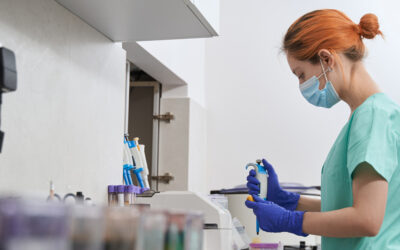Using patient samples for diagnostic quality control introduces significant yet often unrecognized costs and risks. The preparation and long-term storage of these materials can be complex and highly variable, depending on the assay and sample type. Procuring suitable specimens may require extensive trial and error to ensure they fall within the correct analytical range, increasing labor demands and the potential for error. Third-party reference materials provide the standardization and reliability missing in patient samples. By reducing workflow variability, enhancing assay reproducibility, and enabling earlier detection of assay drift, third-party controls improve diagnostic accuracy and efficiency. To illustrate the important differences between patient samples and third-party controls, we interviewed Simon Evans, Microbiology Manager at The London Clinic. After more than 20 years on the bench at Oxford’s John Radcliffe Hospital, Evans now leads microbiology at The London Clinic. He has experience with the full range of QC options: patient samples, kit controls, and third-party controls. He knows firsthand how the instability and biosafety hurdles of patient samples can increase the risk of errors and how a well-chosen multiplex third-party control can expose assay drift before it becomes a problem. If you work in a clinical or public-health lab, this blog post offers insights into the process of choosing the right type of controls for diagnostic assays.
1. Why do you choose third-party controls over patient samples?
With patient samples, although they can be useful in monitoring certain variables and they’re better to show the commutability of results during lot changes, they’re not very stable in the long term. Patient samples also have high variability. So, speaking from a microbiology perspective, we’re never going to get a stable set of results from a group of patients. Their measured values vary widely across runs and equipment. So, by using a third-party control we can create that stability, which will then show that any deviation could well be due to the assay. We can then investigate further and determine whether other laboratories are observing similar trends. And then you can sort of narrow it down further to either the control or the assay and then you can work on it from there. Whereas if we get deviations with our patient sample, we don’t know whether it’s the patient sample or whether it’s the assay. So that’s the benefit that I see of using external controls over the patient samples.
2. How has using third-party controls made QC easy for you?
Using external controls is easy because many of them are multiplexed, so we have many targets being able to run on the one control as opposed to having to find many patient samples that cover all the targets that we have. Some of our assays can have 22 targets in them, so finding a positive sample for each of those is difficult. Some of those samples are going to be higher biosafety level organisms, which we’re not allowed to keep in the lab. It’s against the regulations in this country, so by using a third-party control with an appropriate biosafety level, we’re able to capture all the targets. They’re also more stable for longer periods of time. Their values are more stable, enabling quicker detection of drift and faster root-cause analysis.
3. What was your process internally to verify the patient samples?
Our laboratory is accredited by UKAS (United Kingdom Accreditation Service), comparable to other national accreditation bodies elsewhere, and we follow their guidance for verifying patient samples. Controls have a clear hierarchy: third-party quality controls are preferred as they are independent of the manufacturer and provide the most reliable assessment. If unavailable, patient samples may be used, with kit-supplied controls as the last resort. In every case, we monitor values and track changes across reagent lots.
QC materials must be fit for purpose—compatible with the analyzer, behaving like patient specimens, stable, easy to use, and reliably supplied. When introducing a new analyzer, kit controls confirm functionality, but third-party controls are essential for measuring precision, variability (SD, CV%), and uncertainty. Patient samples then provide clinical comparability, either against an existing analyzer or via reference labs.
Finally, QC performance is continually reviewed to detect drift or errors early. Well-chosen third-party controls are central to this process, as they verify not only the assay itself but also the full testing pathway, ensuring accurate and reliable patient results.
They’re always very vague in their guidelines about what they specify. They do say that if there is a third-party QC available, we should be using that. But if you can’t find a third-party control on the market, patient samples are fine. And if you can’t find a decent patient sample, then use the kit controls. But just make sure that you are keeping track of it and any kind of changes in between lots. The process to verify the patient samples is as follows when we have to bring in a new machine. In fact, we are getting some new machines now and we have to ensure that we have the kit controls which we run to check the accuracy of the assay, but the kit controls are very much engineered to work with the machine so they’re essentially designed to pass all the time. Then we must run our third-party controls as well to make sure we check out the uncertain measurement, check out the standard deviation, check out the coefficient of variation. We need to make sure all of that is within a proper range and make sure that the assay is working. Then we compare the patient samples that we run on our current analyzer against the new analyzer that we’re bringing in. If it was a completely new analyzer and we had nothing to compare it to in-house, we would send it to an outside laboratory for testing to confirm result comparability.
4. What advice do you have for a lab using patient samples to move into using external controls?
I would say think about what assays you’re running, what QC process you need, and what controls are available. In a case where third-party controls may not suit every assay, consider applying a rolling mean to a large set of patient samples. If you have many of the same samples – so a large population of patient samples which can get the same value – you can have like a rolling sort of mean with that one.
But if third-party controls are available for your assay, start by making sure that the third-party control matches up with your assay with the right targets. And obviously do a cost analysis as well. Make sure that the third-party QC is cost effective. And make sure that you are doing all your uncertainty measurements and the coefficient variations. Make sure that the controls are actually working as effectively as they should be.
5. When you switched from patient samples to third-party samples, what did you look for?
The only time we have used a patient sample or patient samples was on one assay that did not have third-party controls available. We’ve typically gone for the kit assays and then the third-party controls, but this assay was for Clostridium difficile toxin testing, and there wasn’t a third-party control available for this one. So, our accreditation body UKAS suggested using patient samples. And so, we had to get patient positive samples and start creating our own controls to run. We had to look for a positive sample, not too high, not at the upper limit of detection, but not so low that it’s going to go negative every other time you run it. You want it to be just above. Then check out to see whether it’s passing. But the problem we found with that is that the antigen positive samples go off very quickly, which likely explains the absence of a commercial control—its analytes degrade rapidly. They will go negative within a week, regardless of how strong the positive is, it will just degrade over time. And after a week it just wasn’t working again. We found we were making up controls and it takes a lot of time, takes a lot of effort, and with those samples, we’re not getting many positive results. It’s a lot of effort for not a lot of reward.
6. If you were to create a control, what would you expect from it?
I would like it to be a multiplex control, so we have multiple targets in that one sample. For example, consider a respiratory panel that includes 21 or 22 different targets—having a single vial that contains all of those targets would be ideal. However, whether that’s technically feasible is another question. It’s likely challenging to include that many targets in a single well. Another important consideration is cost effectiveness, which is always difficult with molecular assays. They are always very, very expensive. It should remain highly stable for at least 12 months. Stability of over a year would be useful. And the makeup of the control should be in a matrix as close to a patient sample as possible.
Finding the right Third-Party Controls
If Simon’s experience has convinced you that third-party controls outperform patient specimens, Microbiologics® has you covered. Our ready-to-use IVD controls deliver:
Broad, multiplex coverage – multiple targets per vial, saving you precious bench time and providing cost savings each run.
Formatted for optimal process monitoring – formulated to be handled and processed like real patient samples and support ISO 15189:2022 traceability.
IVD-registered, third-party status – independent of the assay manufacturer, ideal for detecting drift during lot or platform changes.
Ready to tighten your QC and reduce hidden costs? Explore the full Microbiologics control portfolio or request a sample at microbiologics.com. Your assays and your budget will thank you.
Sources
1. ISO 15189:2022 Medical laboratories – Requirements for quality and competence.
2. CLSI EP12-A2 User Protocol for Evaluation of Qualitative Test Performance.
3. UKAS LAB 05 Guidance on the Application of ISO 15189.
 |
Simon Evans
|
Currently serving as Microbiology Manager at The London Clinic, Simon Evans has over 20 years experience in clinical diagnostics. Prior to working in healthcare, Simons conducted research in animal health.






0 Comments